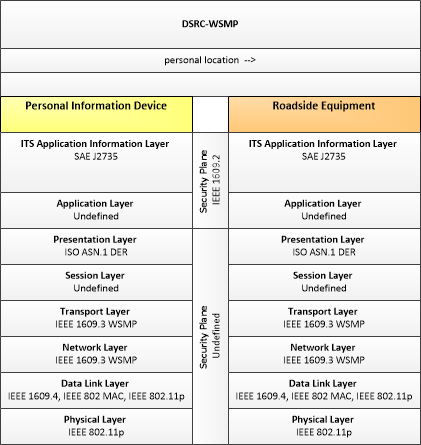Link Type: Short Range Wireless
Personal Information Device --> Roadside Equipment:
personal location
Definitions
personal location (Information Flow): The current location (latitude, longitude, and elevation) reported by the personal information device
Personal Information Device (Source Physical Object): The 'Personal Information Device' provides the capability for travelers to receive formatted traveler information wherever they are. Capabilities include traveler information, trip planning, and route guidance. Frequently a smart phone, the Personal Information Device provides travelers with the capability to receive route planning and other personally focused transportation services from the infrastructure in the field, at home, at work, or while en-route. Personal Information Devices may operate independently or may be linked with connected vehicle on-board equipment.
Roadside Equipment (Destination Physical Object): 'Roadside Equipment' (RSE) represents the Connected Vehicle roadside devices that are used to send messages to, and receive messages from, nearby vehicles using Dedicated Short Range Communications (DSRC) or other alternative wireless communications technologies. Communications with adjacent field equipment and back office centers that monitor and control the RSE are also supported. This device operates from a fixed position and may be permanently deployed or a portable device that is located temporarily in the vicinity of a traffic incident, road construction, or a special event. It includes a processor, data storage, and communications capabilities that support secure communications with passing vehicles, other field equipment, and centers.
Included In
This Information Flow is in the following Applications:
- Incident Scene Work Zone Alerts for Drivers and Workers
- Pedestrian in Signalized Crosswalk Warning
- Pedestrian Mobility
- Route ID for the Visually Impaired
- Warnings about Hazards in a Work Zone
This Information Flow is in the following Application Objects:
Communication Diagrams
The communication diagram(s) can be viewed in SVG or PNG format and the current format is SVG. Switch to PNG format.
Characteristics
Architectural:
| Characteristic | Value |
|---|---|
| Time Context | Recent |
| Spatial Context | Adjacent |
| Acknowledgement | False |
| Cardinality | Broadcast |
| Initiator | Source |
Security
This information flow triple is in the following applications with the following security levels.
| Information Flow Security | |||||
|---|---|---|---|---|---|
| Application | Confidentiality | Integrity | Availability | ||
| Basis | Basis | Basis | |||
| Incident Scene Work Zone Alerts for Drivers and Workers | Not Applicable | High | Moderate | ||
| This data is intentionally transmitted to everyone via a broadcast. It can also be determined via other visual indicators. | As long as the emergency personnel stays within the geofenced area, it should not matter if this information is accurate. However, an incorrect locations message, saying that the person is outside of the geofenced area, could lead to a false warning. If they were actively helping a person, and then received a notification about an imminent collision because their location was inaccurate, it could lead to worse conditions for the person they're helping. | There are other visual indicators about the geofenced areas. Emergency personnel should know when they are leaving a geofenced area. As long as they remain in the geofenced area, this information is not as necessary. Additionally, not all emergency personnel may have this, and they should still be protected. | |||
| Pedestrian in Signalized Crosswalk Warning | Low | Moderate | Low | ||
| This data is intentionally transmitted to everyone via a broadcast. It can also be determined via other visual indicators. | If this information is incorrect it could cause the system to broadcast inaccurate messages, saying that a pedestrian is in an intersection that does not have anyone in it. It could also cause a failure to alert if the information was not accurately broadcast that the person was in the intersection. Too much inaccuracy in this information could lead to people ignoring valid warnings. | This information should not be required to determine if a pedestrian is in an intersection. Not all pedestrians will carry a personal information device, and the system should be able to operate without this information. | |||
